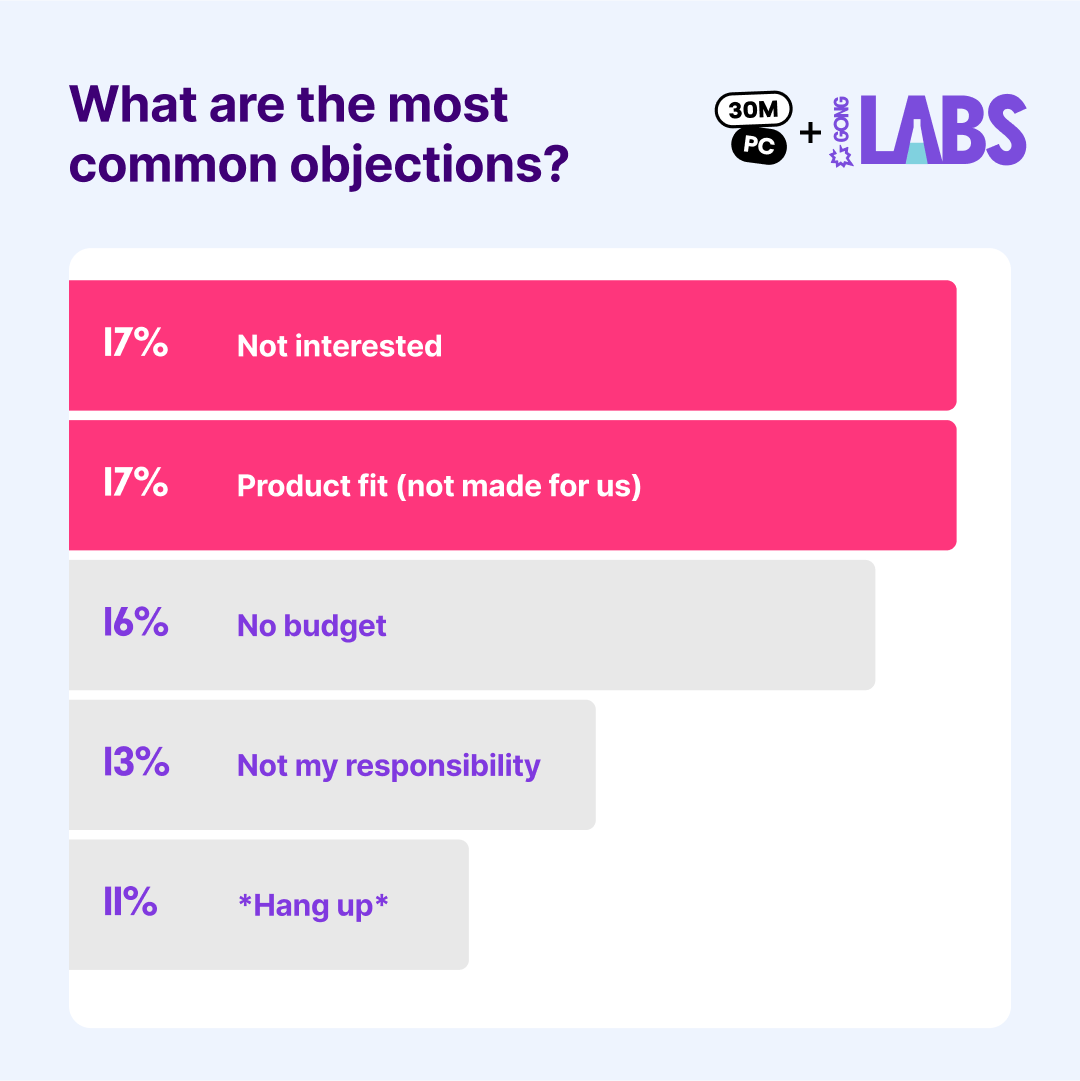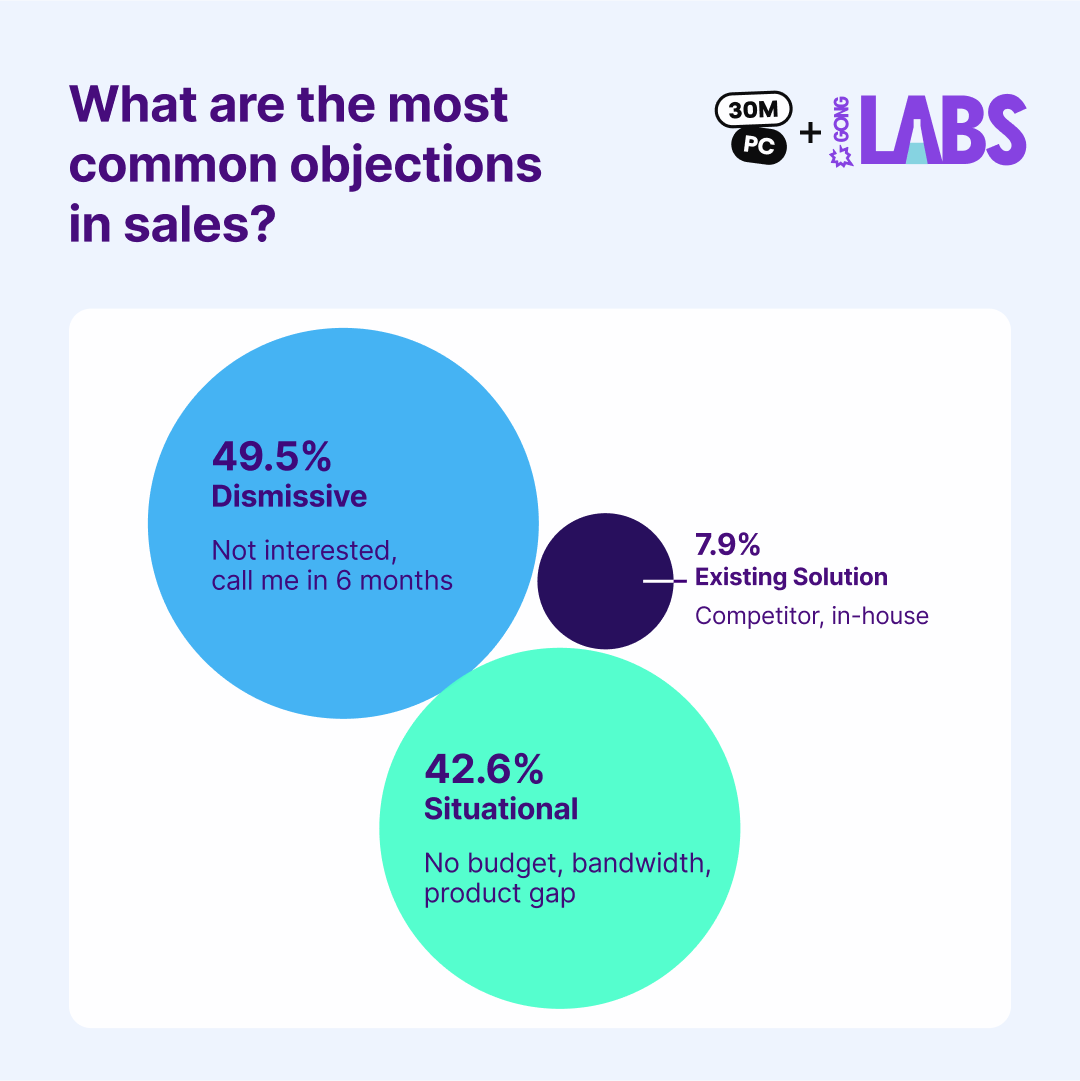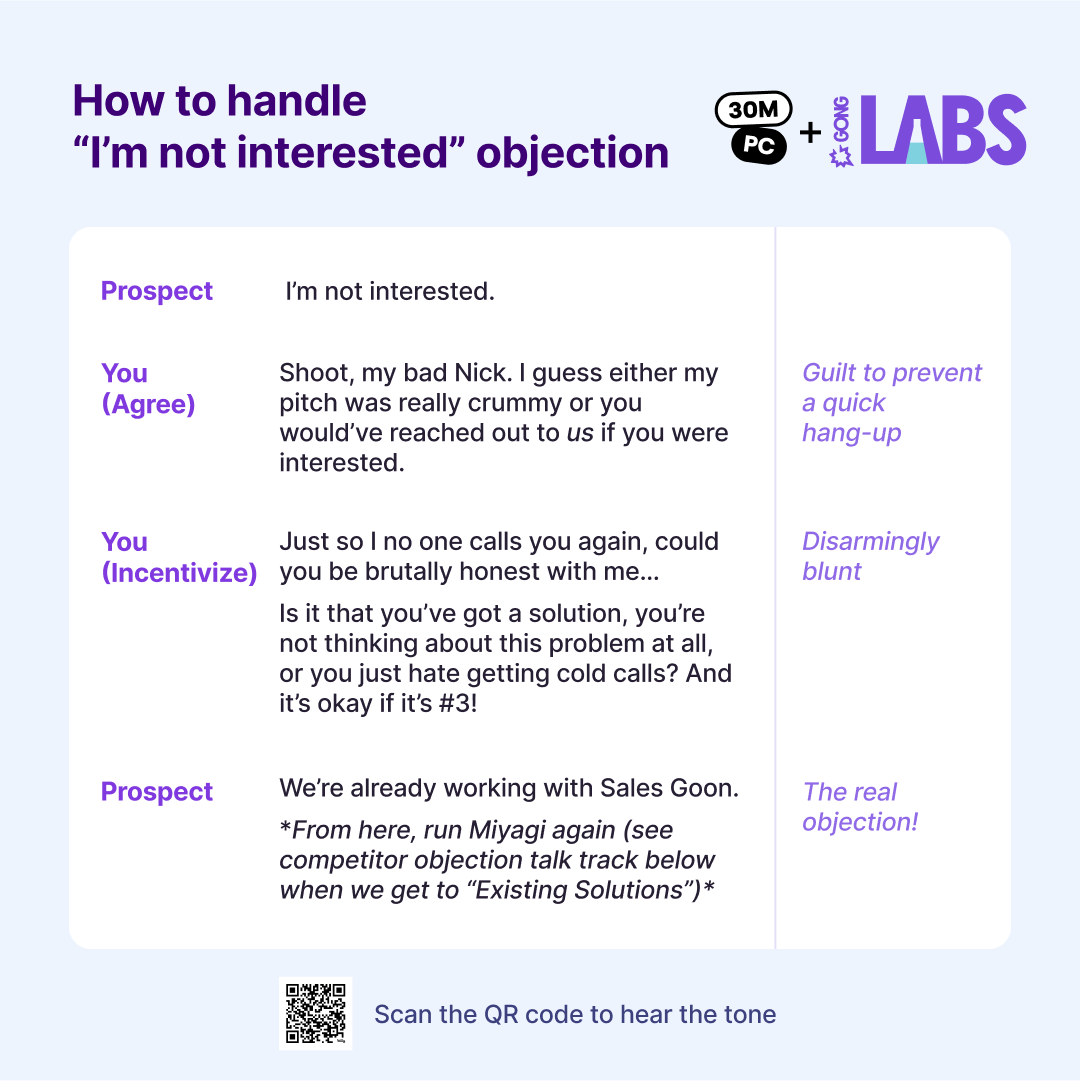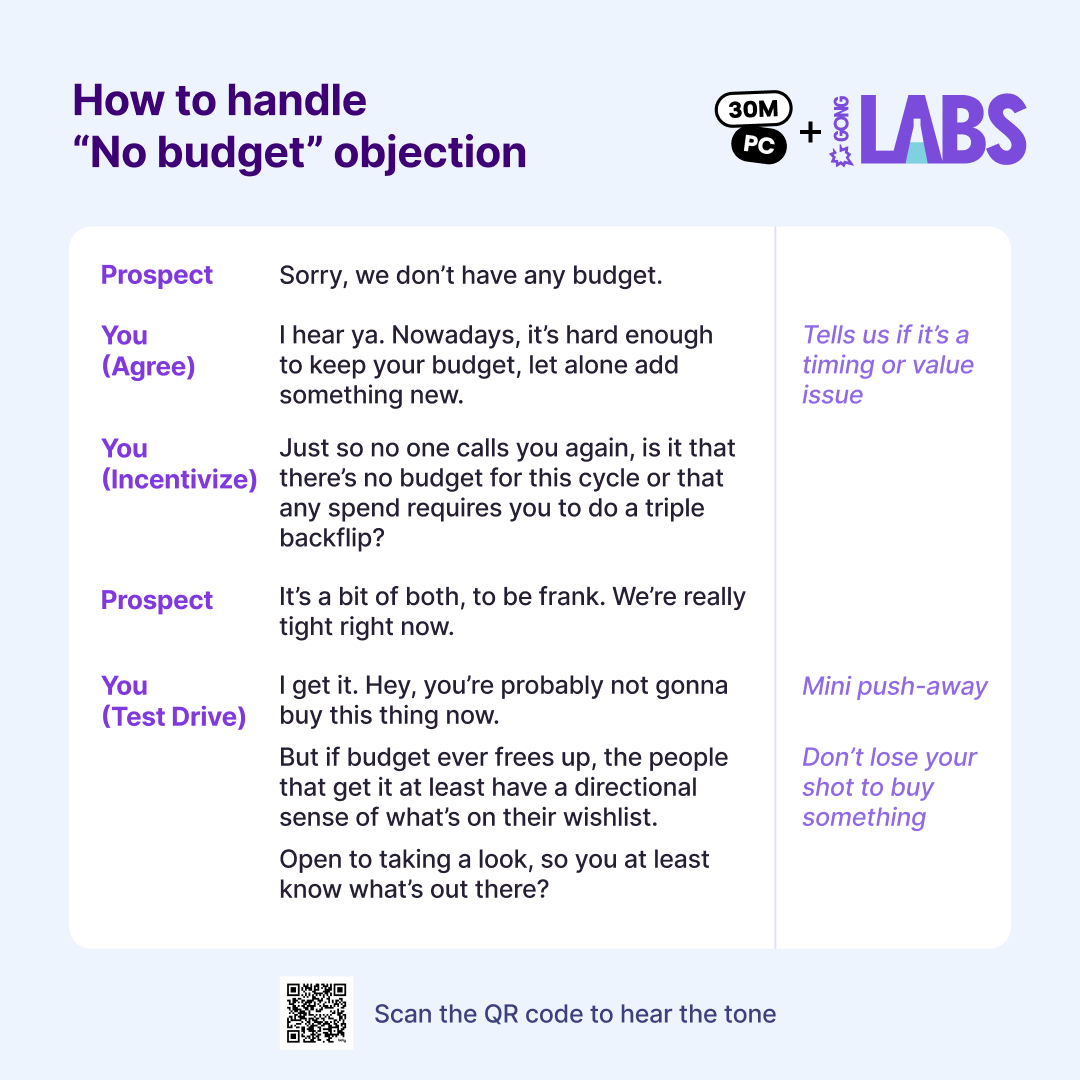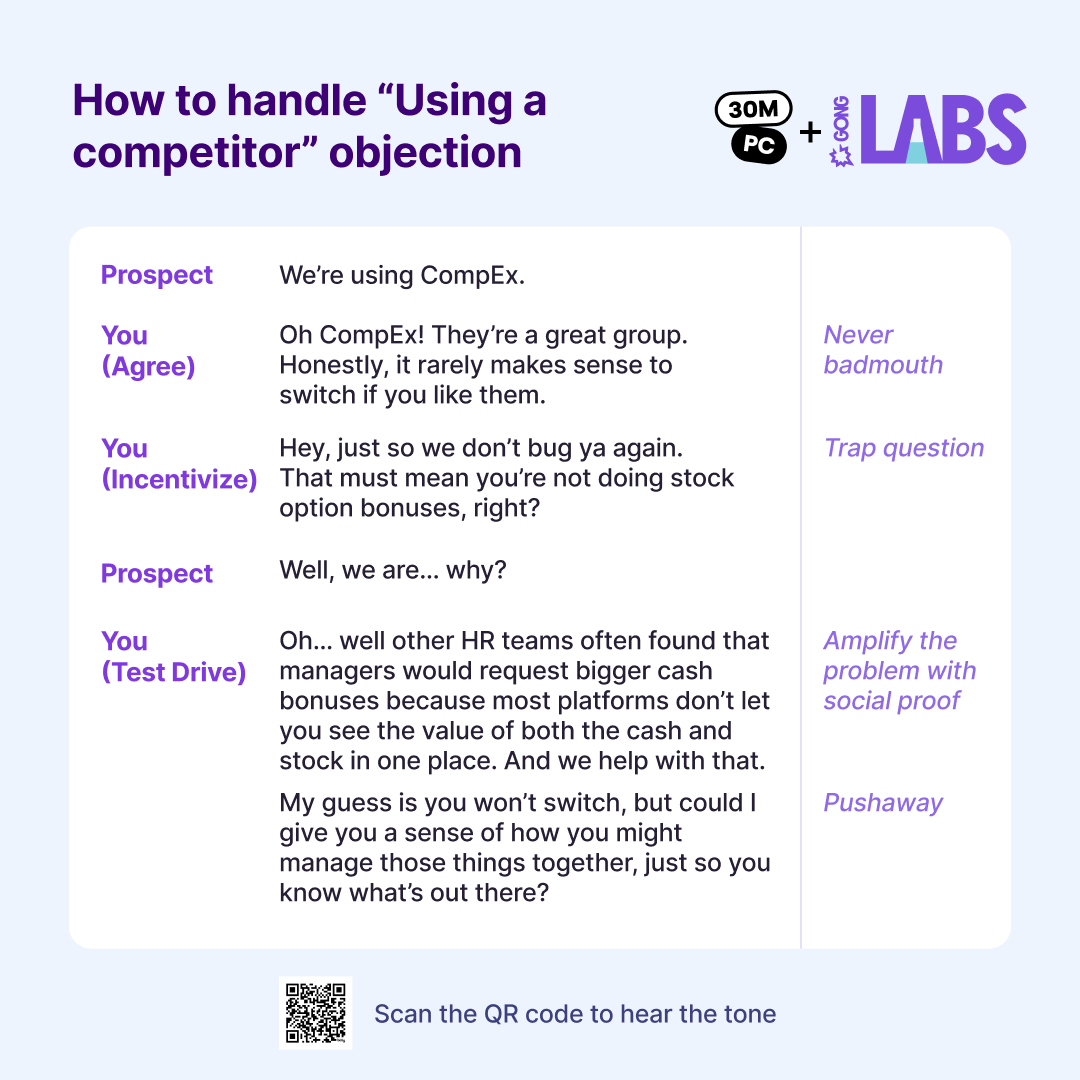We found the top objections across 300M cold calls; here’s how to handle them all

This article is part of a special Gong Labs x 30 Minutes to President’s Club cold calling series in celebration of our book release: Cold Calling Sucks (And That’s Why It Works). If you like this, reserve your copy of the book here and subscribe to Gong Labs or 30MPC for more data-backed sales tips.
Handling objections is the hardest part of cold calling.
Your opener and pitch are usually the same, but you have no idea what will come next …
- I’m not interested.
- Where’d you get my number!?
- I’m using this [random niche competitor you’ve never heard of].
That’s exactly why we analyzed 300M+ cold calls. After crunching the numbers, we identified the most common objections and then categorized them to simplify the proven approach you should use to overcome them.
In this article, we’ll cover:
- The 3 types of objections (by %)
- The approach you should take for each type of objection (with talk tracks)
- A proven framework to handle any objection
Let’s dive in.
The most common objections you’ll face
The top 5 most common objections actually account for 74% of all objections. If you master these, you’ll be covered 3 out of 4 times, which is pretty darn good:
But the reality is that these can vary greatly from company to company.
Therefore the key to handling objections is to think about them in categories, not specific objections.
Think about it. It’s nearly impossible to memorize 20 talk tracks for every single objection.
But if you break objections down into buckets, the approach for each of them isn’t so different.
Here’s how they break down.
The 3 types of objections and how to handle each of them
How to handle dismissive objections
Dismissive objections represent 49.5% of all objections and are the most common knee-jerk reactions to a cold call, including:
- Not interested
- Call me in 6 months
- Send me some information
- Not my responsibility
- Where’d you get my number!?
- I’m in a meeting
- Is this a cold call?
- I thought you were someone else
- hang up
The hardest part about dismissive objections is that they’re not real objections. You have nothing to work with because you have no idea why they aren’t interested or why you should call back in 6 months. So you have to agree and incentivize them to share the real objection first.
These can also escalate into some of the most abrasive objections of them all. It’s one thing to reason with someone who says I’m not interested. It’s another to reason with an irate prospect yelling, “Is this a cold call!?”
Your natural reaction will be to stammer, apologize, and scurry away. Do the opposite.
Dispel the tension with “Disarmingly Blunt” transparency and humor. The more ridiculous their reaction, the more ridiculous your opposite counter-reaction should be.
For example, if you were handling “I’m Not Interested,” your talk track might sound like this (scan the QR code to hear the tone):
How to handle situational objections
Situational objections represent 42.6% of all objections and happen when their situation and your product don’t line up, including:
- Too expensive
- No budget
- No resources / bandwidth
- We need to hire someone first
- Product fit (not made for us)
Buying products means an investment of time, money, and people.
Even if they see the benefits, they imagine all the work they’ll have to do to realize them: begging for budget, assigning someone to manage the project, burning political capital if it doesn’t work.
The cost of the transition outweighs the benefits of the product, so you have to remove all the pressure of buying the car until you get them so excited that they realize it’s worth it.
You do that with the test drive. Once they’re in the car, we can blow their mind with the drive, explain how easy it is to finance the car, and let them drive it off the lot today.
But not on a cold call. Get them in the car.
Let’s try that with the “No Budget” objection. Putting this into practice, we’ll remove the pressure of the purchase entirely. Instead of convincing them to secure budget today, we’ll sell the test drive by giving them a way to win more funds for their team later (and everyone wants more stuff).
Here’s how that plays out in a talk track(scan the QR code to hear the tone):
How to handle existing solution objections
Existing solution objections represent 7.9% of all objections. They’re alternatives to your product, such as in-house solutions, competitors, and being stuck in a contract, including:
- We do it in-house
- Competitor (known)
- Competitor (unknown)
- Stuck in a contract
Reps make the mistake of criticizing and throwing mud at a prospect’s current solution, which only makes them defensive and far more likely to push you away.
That said, even if they’re happy with their solution, no solution is perfect. If you can get them to realize a problem on their terms instead of your terms, they might be open to a solution.
Here’s how that plays out in the Miyagi Method:
- Agree with their current solution so that they don’t get defensive.
- Incentivize conversation with a trap question to poke a hole in their solution.
- Sell the test drive with social proof or why other people like them switched.
Let’s take on a competitor as an example. I sold compensation software as the VP of Sales for a company called Pave.
We were 2-3x the price of our competitors because we could manage stock option bonuses that were too complex for our legacy competitors to handle. That made for a perfect trap question.
The tone is really important when revealing flaws in someone’s solution. Lean into the pushaway. Listen to the talk track below:
In our book, Cold Calling Sucks (And That’s Why It Works), we walk through three steps to handle any objection (like Mr. Miyagi):
Step 1: Agree With The Objection. Objections are often a reaction to the interruption, not your pitch. When you agree with the objection, it feels really dumb to keep fighting someone who isn’t fighting you. That gets them listening instead of reacting.
Step 2: Incentivize Conversation. You still don’t have enough information to handle the objection and they’re still not comfortable enough to hear you out yet. So get them talking and incentivize them to share more by saying… we’re never gonna cold call you again.
Step 3: Sell the Test Drive. So here’s the trick: You still don’t want to sell your product. If you do that, red alert defense mode goes right back up. You want to sell the test drive: Why should they take a look at the car, even if they don’t buy it?
Master every moment in your cold calls
In our latest guide, we’ve distilled all of the lessons learned from the 300M cold calls we analyzed and put them in one place. Our latest guide, “How to master cold calls” reveals:
- The answer to everyone’s question: Does cold calling still work?
- How to nail your opener and pitch, every time.
- The most common objections and how to navigate them.
- Best practices and insights to maximize your connect rate.
Give these data-backed tactics a try the next time you pick up the phone. It’s all free and for the taking here.

